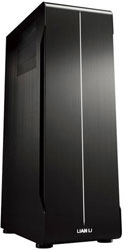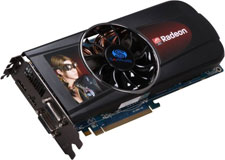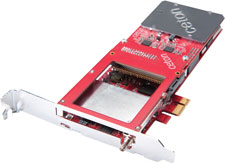Holiday 2010 System Builder's Guide
by AnandTech Staff, edited by Jarred Walton on November 19, 2010 2:00 AM EST- Posted in
- Guides
- Systems
- Holiday 2010
Alan's Ultimate HTPC: Bringing Total Entertainment to the Living Room
Our final build is for those of you who do not like to compromise with your HTPC. Are you tired of hooking up multiple streaming boxes to get all your internet content, NAS for secondary streamers, and another gaming system as well? There are numerous users out there, myself included, that love HTPC as well as gaming. There are many ways to skin the proverbial HTPC cat; this guide is for those of you who want it all in one box on your big screen. There will be sacrifices however, and those come in the size department and in the old pocket book. If you're looking for a small, quiet HTPC that isn't as powerful but doesn't cost an arm and a leg, go look at what Ganesh is pushing.
| Alan's Ultimate HTPC | ||
| Hardware | Component | Price |
| Processor |
Phenom II X6 1090T Black Edition (Thuban 45nm, 3.2GHz, 6x512K L2, 6MB L3, 125W) |
$210 |
| CPU HSF | Noctua NH-D14 | $75 |
| Motherboard | MSI 890FXA-GD70 (AMD 890FX AM3) | $200 |
| Video | Sapphire Radeon HD 5870 1GB (100281-3SR) | $300 |
| GPU HSF | Arctic Cooling Accelero Xtreme | $57 |
| TV Tuner | Ceton InfiniTV4 CableCARD Quad-Tuner | $400 |
| Memory |
G.Skill Ripjaws 2x4GB DDR3-1600 CL9 (F3-12800CL9D-8GBRL) |
$150 |
| OS Drive (SSD) | OCZ Vertex 2 120GB ($20 MIR) | $210 |
| Misc | Icy Dock MB882SP-1S-1B | $20 |
| Hard Drives | 3 x Western Digital Green 2TB (WD20EARS) | $300 |
| Optical Drive | LG UH10LS20 Blu-ray Combo Drive | $85 |
| Case | Lian Li PC-X2000F | $300 |
| Power Supply | Seasonic SS-560KM 560W (80 Plus Gold) ($15 MIR) | $115 |
| Mouse | Razer Mamba | $110 |
| Keyboard | Logitech diNovo Edge | $157 |
| Software | Windows 7 Professional 64-bit (OEM) | $135 |
| Software | Hipporemote Pro | $5 |
| Software | PowerDVD 10 Ultra | $90 |
| Misc | Powermat for iPhone 3GS (PMM-1PB-B2A) | $41 |
| Total System Price | $3015 | |

The first thing to look at for an HTPC is the case, and the most important feature in the case of an HTPC is noise. This is the major problem with multipurpose machines. Gaming cases tend to stay cool but also tend to be noisy and filled with enough LEDs to be mistaken for a flight beacon; after all gamers tend to want to highlight all their high-end hardware. Finding components that will both be cool enough for gaming and quiet enough for a home theater is the key here. A great best of both worlds case is the Lian Li PC-X2000F. At $299 from Newegg as of this writing, the case is pricey, but it currently sports a $200 saving (though that may disappear soon). At that price, I think it is an excellent buy for a home theater/gaming enthusiast.
New to this version is USB 3.0 support and a redesigned case layout. With five 140mm fans, dust filters, and anti vibration solutions, the air-cooling is both highly effective and extremely quiet. Sporting seven HDD bays with the installed back plates for hot-swappable fun, this case has plenty of room for media drives; just make sure your motherboard or RAID card have enough SATA connectors.
Speaking of storage, currently 2TB WD20EARS drives are shipping for $100 and are a great way to expand your media storage capabilities and tend to run on the quiet side of things—no need for a NAS when your HTPC case holds enough traditional HDDs to feed every other device in your home with media! The case is limited to 3.5" drives, but throwing your favorite SSD into an Icy Dock or similar device will allow you to push it right into one of the HDD back plates to get your OS and applications loading at high speed with no noise whatsoever.

For the GPU, I chose AMD because of the bitstreaming support for HD audio codecs. We can argue about performance with the 5870 and 6870, but the 5870 has been around enough that aftermarket cooling solutions are readily available. Add a Noctua cooler to your favorite CPU as well as an Arctic Cooler Accelero on your high-end AMD graphics card for cool and quiet gaming that won't leave you straining to hear during quiet movie scenes. We've also selected a high-efficiency, near-silent 560W power supply from Seasonic to keep everything running; the GPU + CPU combination generally means we need more power than a typical HTPC, but since this is the main feature of the Home Theater/Gaming we went higher end.
At this point, we've taken your NAS or Windows Home Server, HTPC, and gaming PC and combined them into one glorious entertainment system. You'll need help accessing all that media however. Free applications like Boxee and My Movies 3 can help sort local and internet content past what Windows Media Center offers, but pay applications like PowerDVD will integrate well with Media Center and will also play nice with My Movies adding Blu-ray capability into the mix. But there's still more….
The smartphone is one of the best ways I have found to control a Windows-based HTPC. With HippoRemote on your phone and HippoVNC booting on your PC, you can use your smartphone to seamlessly open Windows Media Center, Boxee, Hulu, or myriad other applications. The touchscreen on the phone then transforms into a remote interface designed for the application of your choice. It is a great way to navigate seamlessly between applications that bring you internet or media content without having to browse endless webpages, and there's no need to hack Media Center. The problem is, using your smartphone in this manner depletes the battery at a rapid rate; that's why adding a Powermat on the coffee table will address this problem and charge your smartphone/remote each time you set it down. You'll still want a good wireless mouse as well as a keyboard for gaming. I like the Razer Mamba mouse, while the Logitech Dinovo Mini or Edge are excellent options for the keyboard.

Last but not least, you can add cable TV into your HTPC with a Ceton InfiniTV 4 CableCARD tuner. Although quite expensive and backordered, they bring four simultaneous HD streams into your PC through a single card. Streams can be accessed in other rooms via the Xbox 360, or by adding a network bridge to the tuners (a process still in beta firmware, but it should be available by the time the cards are out of backorder). Or, if you're one of those looking to cut the cable, save $400 and stick with streaming video.
You can see my list of components up top, but play around with what works best for you. I went with an AMD setup to keep the cost slightly lower and chose a single GPU as the system will likely be hooked to an HDTV that will limit the resolution for gaming to 1920x1080. Sadly, the single most expensive item is the CableCARD tuner. But for around $3000, you'll be ripping Blu-rays onto 6TB of storage, controlling your media with your phone, and playing the latest games on your 1080p TV. Enjoy!










112 Comments
View All Comments
SteelCity1981 - Friday, November 19, 2010 - link
I honestly don't care if I have the latest tech. the way I look at it new tech comes out every 6 months to a year anyhow. I get tech that suits my needs not what's out there. I'm one of those people that wait until the current tech gets replaced by the latest tech which ends up pushing the last gen tech down in price.I'll prob be looking at a first gen AM3 system or a LGA 1156 system early next year to replace my aging S939 system I currently have now. By then a lot of the processors and sockets for those systems should see a nice price drop from where they are now.
mapesdhs - Friday, November 19, 2010 - link
A small note on budget systems one might build for friends, etc.
(especially those without the tech knowledge). I built a PC for my
neighbour & his family back in May; decided to see what I could do re
mixing 2nd-hand 'professional' parts and consumer tech, try to make
something with a bit of quality. I found a mbd/CPU/gfx/RAM combo for
135 UKP (ASUS M2N-BM-DVI, Athlon64 X2 6000+, OCZ 2GB DDR2/800, ASUS ORB
8800GT PCIe), LSI 21320-IS SCSI card for 5, U320 SCSI 73GB 15000rpm
Fujitsu MAX3073NC and cable/adapter for 15 (knocks the socks off SATA
for access time), and a company was offering a new Coolermaster
Centurion Plus 534 case half-price for 25. The rest I bought new: 500GB
SATA Samsung F1 for 40 (as it was back then), CiT 700W PSU for 30,
Wireless 54Mbit PCI card for 7 and DVDRW for 18. Total: 275 UKP
The main idea was to have a fast & responsive system disk, but with a
normal SATA for data, so it feels very nippy but still has decent
storage. The resulting setup ran very nicely (and the mbd combo came
with Stalker, complete/boxed. :)
http://service.futuremark.com/compare?3dm06=138917...
For a display though, I recommended they buy new, something decent,
which they did for 138 (LG W2254TQ-PF 22" 1680x1050, 2ms, 300 cdm/2,
1000:1). Same cost today gets 1920x1080.
They do a lot of surfing, so the fast system disk really helps.
Just thought I'd mention for those who like to be a bit adventurous...
(the landscape of what is available has changed since then, but the
same concepts still apply)
Ian.
PS. Access time speed ref (the Fujitsu beats a WD VR 10K):
http://www.sgidepot.co.uk/diskdata.html#ACCESS
precarious - Saturday, November 20, 2010 - link
"never mind the old single-core Athlon 64 3800+ running in my daughter's computer!"does she really need more than that to download recipes and msds sheets for the latest household cleaning products?
JarredWalton - Saturday, November 20, 2010 - link
FYI, my daughter turns eight tomorrow. LOL It's more like Noggin.com for her.ManjyomeThunder - Saturday, November 20, 2010 - link
I see that you mention the Das in your ultimate-uber-badass dream gaming rig. And that's perfectly fine, it's a great keyboard, but I thought I'd take a second to clarify a few things.1) The link specified is for the "Silent" model of the Das Keyboard, which uses non-clicky, tactile Cherry MX Brown switches. While these keyboards do provide tactile feedback just like, say, the Model M, the majority of any sound produced is from "bottoming out" the keys. The normal Das keyboard uses Cherry MX Blue switches, which are tactile and clicky, and produce a more distinct sound like the Model M, only much more high pitched.
2) The Das Keyboard is far from being the "modern Model M". If anything, the direct equivalent of the Model M would be the Customizer 101, manufactured by Unicomp in Lexington, Kentucky. They own the rights to the patents and such on the Model M, and produce nearly identical keyboards for an affordable price. I'm typing on a black Customizer 104 now, which costs a fair bit less than the Das keyboard. There are also somewhat smaller models such as the "SpaceSaver" available. Make sure to pick up a model that uses "buckling spring" switches (most of theirs do), because that's what makes it mechanical and clicky.
3) In addition to Unicomp, there are a large number of mechanical keyboards, including Razer's new BlackWidow, the Deck Legends, Filco Majestouches and Steelseries 7G. There are a lot of different switches, each with their own unique properties, so it's best to look into these things before you buy them. A good place to start would be over at GeekHack. We're all keyboard nerds there.
raghu1111 - Saturday, November 20, 2010 - link
I would like to know estimated idle power consumption for AMD and i3 budget systems. Dell 580s with i3 550 lists idle power at 40 watts.. which is very good.My use case : this is an always on computer running ubuntu. I don't plan to put it in sleep mode and hence the sensitivity to power consumption. I have been using a laptop as desktop for this reason so far.
JarredWalton - Saturday, November 20, 2010 - link
Here's Anand's figures from Bench for two similar setups:http://www.anandtech.com/bench/Product/122?vs=143
Note that those both have a 5870 GPU, so you can knock off around 10-15W if you go with IGP or a low-end GPU. I figure an Intel i3-550 setup can probably get down to around 40W idle power draw for the entire system, depending on components, where an Athlon II X4 will end up 10-15W higher. Running 24/7 you're looking at a power bill difference of around $10-$15 per year in most places, so it's nothing major -- though if you were doing something like a Folding@Home PC I think the difference might be more like 35-40W at load.
raghu1111 - Saturday, November 20, 2010 - link
Thanks Jarred. The page lists 66 W at idle. IGP should be good enough to start with for me. I can disconnect DVD drive (may be just a couple of watts). May be I am looking at best case of 50 W.Out of Box Experience - Saturday, November 20, 2010 - link
I want a tablet PC that can control a REAL computer in realtime, with compressed graphics sent wirelessly from my tower to the tablet at FULL frame rates.It needs wireless usb3 for sending data and controlling the tower with bidirectional throughput (USB2 is a one way street)
I also want a mini-ITX tower with a built in KVM switch and a power supply that can handle 2 or more motherboards
I want hard drives that have a read only switch (like SDHC cards) so I can backup ALL my stuff without worrying about viruses & worms
I want mini-itx motherboards with built in digital audio amps (Low powered for mobility)
and while I'm dreaming, lets make XP-Pro open source so we can fix it properly and add SSD support!
and I want it all by Christmas
Thanx Santa
raghu1111 - Saturday, November 20, 2010 - link
What would be the idle power consumption for i3 550 based budget system. would AMD based much different. Dell lists Inspiron i3 550 based 580s at 40 Watt, which is pretty good.My use case : always-on Ubuntu desktop. not planning to set it to sleep mode. 3D graphics performance is a not an issue.
Thanks.